A creamy pot of yoghurt not only makes a delicious breakfast, dessert, or snack but also has many health benefits. If you are looking for a more cost-effective way to buy yoghurt, a cheaper dairy-free option, or a healthier, sustainable alternative to store-bought yoghurt, then a yoghurt maker will be an investment that will be paid off very quickly.
Unlike store-bought yoghurts that contain additives, homemade yoghurt is free from thickeners and sweeteners. Making it is simple—just heat the milk, add live cultures, and let it incubate until it thickens. Using UHT milk skips the heating step, and with an appliance that offers precision temperature control and a timer, you can make yoghurt exactly how you like it. Alternatively, you can also use a multicooker or slow cooker with a yoghurt setting.
Best yoghurt makers at a glance:
• Best overall yoghurt maker: Lakeland Multi Yoghurt and Soft Cheese Maker – Buy now on Amazon UK
• Best yoghurt maker for big batches: VonShef Yoghurt Maker Machine with Strainer – Buy now on Amazon UK
• Best yoghurt maker for individual servings: VonShef Digital Yoghurt Maker with 7 Jars – Buy now on Amazon UK
What's not to love about yoghurt? It can be high in protein, calcium, vitamins and live culture, which helps promote good gut health. Recently, there has been evidence to suggest that including dairy milk in your diet can reduce the risk of bowel cancer. However, the downside is many yoghurt brands are packed full of sugar and additives so that you won't reap the benefits of the live bacteria or the probiotics. When making your own at home, you control all the ingredients you put into your body.
A purpose-built electric yoghurt maker takes the guesswork out of getting the right temperature for fermentation. It’s not just for dairy—you can also make yoghurt from soy milk. Some models come with a straining accessory to remove excess whey, giving you thick, creamy Greek yoghurt. Some appliances even allow you to make soft cheese by adding lemon juice. Plus, if you have an ice cream maker, you can easily make healthy, budget-friendly frozen yoghurt as a low-calorie ice cream alternative.
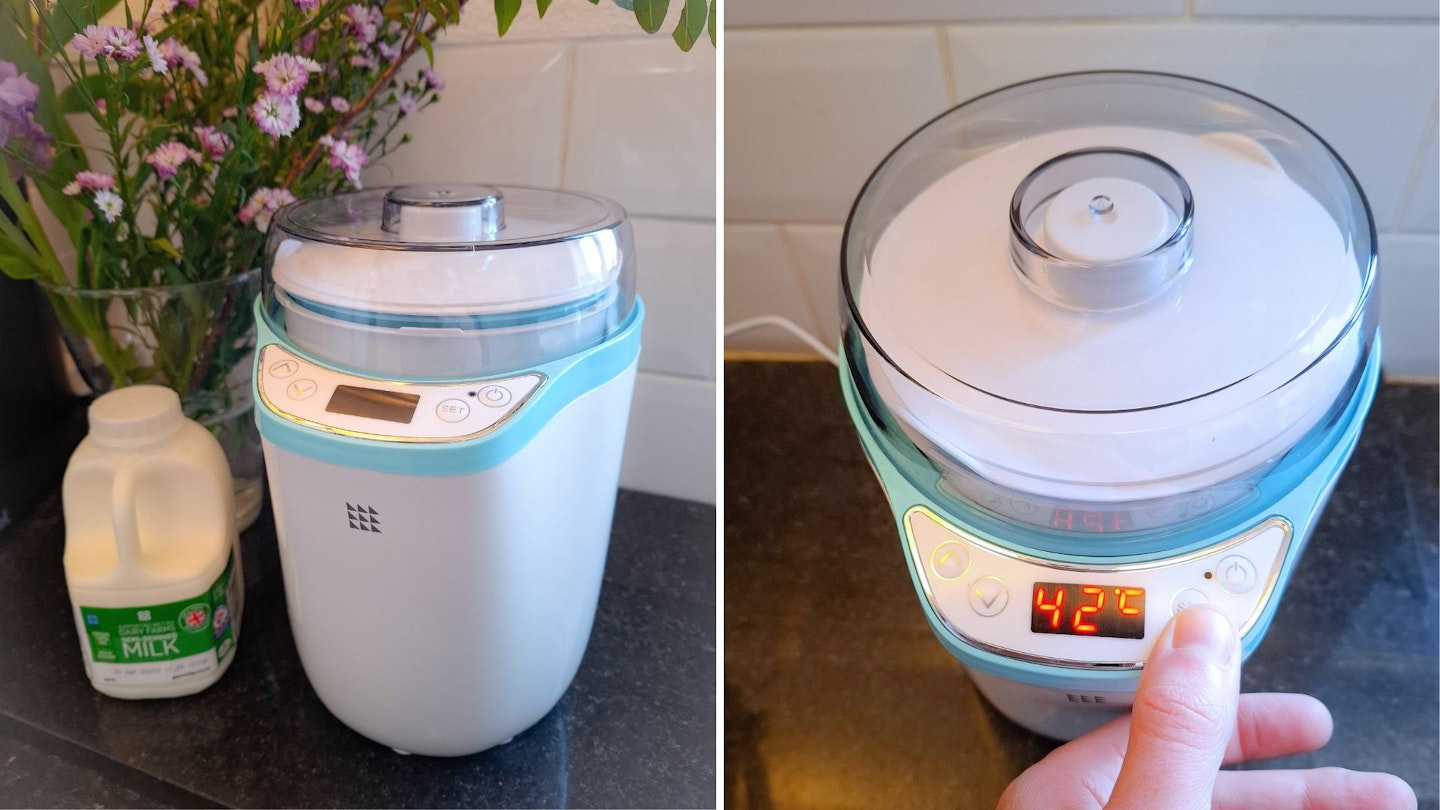
With that in mind, here are our top picks of the best yoghurt makers so you can make sustainable, cost-effective and healthy yoghurt at home.
Best yoghurt makers for sweet treats
The Lakeland Multi Yoghurt and Soft Cheese Maker is the best overall yoghurt maker for home use due to its versatility, ease of use and excellent value for money. Designed for those who enjoy fresh, homemade yoghurt, it allows you to prepare large batches with minimal effort, giving you full control over ingredients, flavours and texture. As one user puts it: "Yoghurt tastes far better than shop-bought." Our tester completely agrees: "Homemade yoghurt has a fresher, creamier taste, and I love that I can adjust the flavour and consistency to my preference."
Whether you prefer plain, Greek-style or dairy-free yoghurt, this machine caters to all dietary needs and can also be used to make soft cheese. "My partner and I have yoghurt as part of our breakfast every morning. I like tangy Greek yoghurt, and he enjoys fruit-flavoured yoghurt. This machine makes it so easy to prepare both."
With its large capacity, this Lakeland yoghurt maker includes two containers—one with a 1.8-litre capacity (holding up to 1.6 litres of yoghurt) and another with a 1.6-litre capacity (holding up to 1.5 litres). This makes it ideal for families or those who like to prepare yoghurt in bulk. "This is such a good investment if you have a household that gets through a lot of yoghurt like we do," says our tester.
The included strainer allows easy preparation of thick Greek-style yoghurt or creamy soft cheese by removing excess liquid. "For Greek-style yoghurt, the strainer allows the whey to separate, producing thick and creamy set yoghurt. You can even make soft cheese by combining whole milk and lemon juice, which I know my partner will enjoy."
The machine features a digital display with adjustable time and temperature controls. This level of customisation helps achieve the perfect consistency and taste. "The controls are extremely easy. The temperature defaults to the C-1 programme, which is a cycle of 42°C, and the timer defaults to 8 hours. There is also a C-2 cycle, which gives you a temperature range of 25°C to 65°C and a time range of 1 to 99 hours to experiment with different ingredients, times and temperatures."
One of its greatest advantages is its hands-off convenience. Simply set the desired time and temperature, and the machine takes care of the rest while you go about your day. However, it is worth noting that some online reviews mention that the temperature control can sometimes be slightly inconsistent, so occasional monitoring may be needed to ensure the best results.
For added peace of mind, the Lakeland yoghurt maker comes with a three-year warranty, offering protection against any potential faults. Its large capacity, multi-functionality and ease of use make it the best choice for anyone who enjoys fresh, homemade yoghurt and soft cheese. Plus, by making your own, you can be sure that your food contains only natural ingredients—free from additives or preservatives. "You need a small amount of unflavoured, plain, natural yoghurt as a starter. It’s the probiotics in the yoghurt that will turn the milk into yoghurt. Then, like sourdough bread, I use a little yoghurt from the last batch as a starter for the next batch," says our tester. The instruction manual advises that this can be done for up to three batches; then, it's best to start with fresh yoghurt culture.
Fresh milk must be boiled before being used in a yoghurt maker, but you can bypass this stage by using UHT milk. Our tester says, "I used semi-skimmed milk, which gives a thinner consistency, but it can be thickened with milk powder."
Our tester was impressed with the recipes included in the manual, commenting: "The instruction manual that comes with the Multi-Yoghurt Maker is really informative and goes beyond the appliance itself to give you tips about using yoghurt in recipes and baking with yoghurt."
The machine itself is quite compact: "It’s about the same height as a carton of milk," making it easy to store on the counter or in a cupboard. Overall, this yoghurt maker is an excellent investment for anyone who enjoys fresh, homemade yoghurt and soft cheese and saving money on store-bought products.
Pros
- Excellent value for bulk yoghurt-making
- Can make both yoghurt and soft cheese
- Suitable for dairy-free yoghurt making
- Comes with two large containers and a strainer
- Informative instruction manual with recipe inspiration
Cons
- Some customer reviews comment that the temperature control can be temperamental, requiring monitoring
| Quantity of yoghurt per batch: | 1.8L container yields 1.6L and 1.6L container yields 1.5L |
| Dimensions: | 15.5 x 18 x 24cm |
Best yoghurt maker for big batches
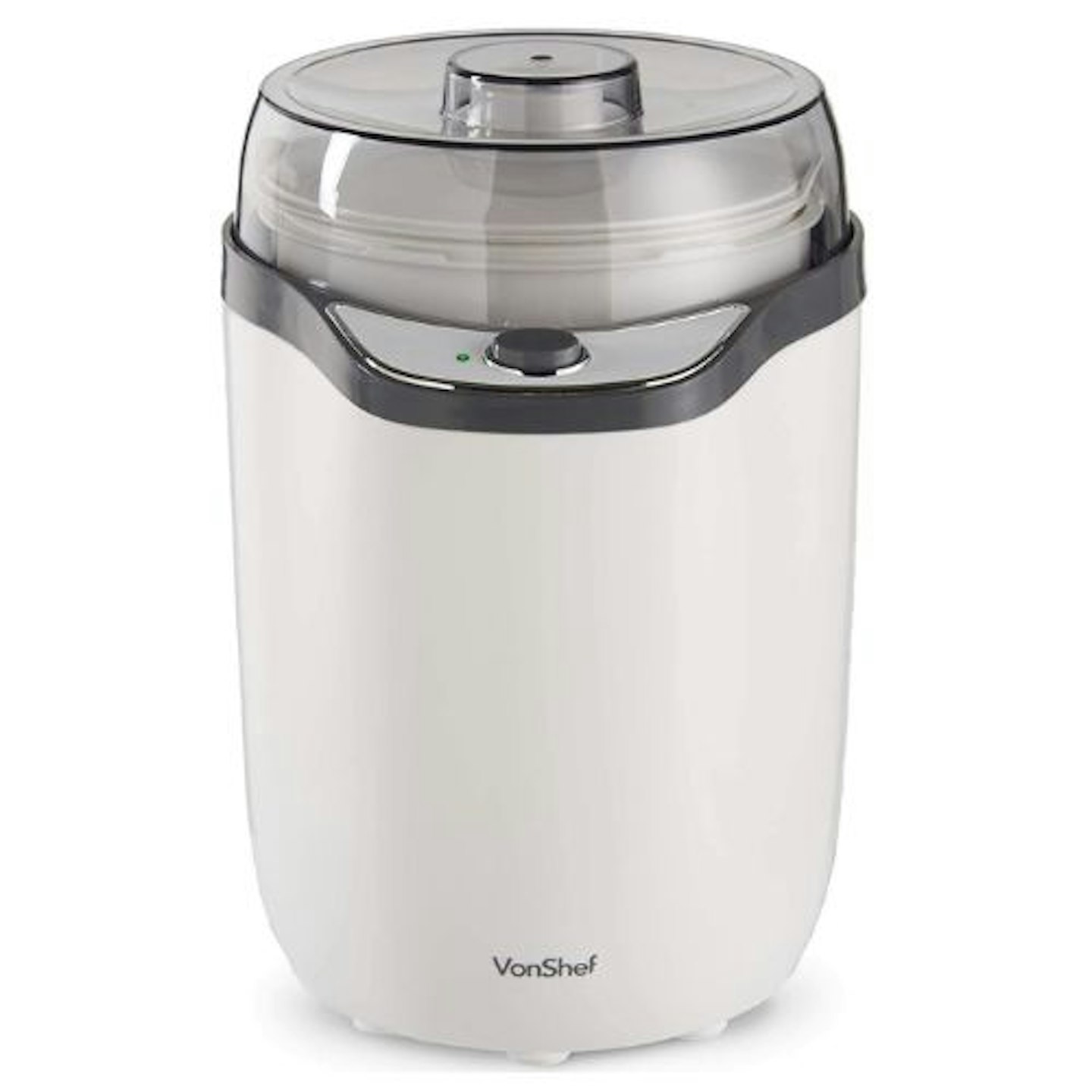 VonShef
VonShefThe VonShef Yoghurt Maker is the best choice for making large batches of yoghurt due to its generous 1.8-litre capacity and cost-effective operation. If you regularly consume yoghurt or want to prepare multiple servings at once, this machine allows you to produce a substantial amount for a fraction of the price of shop-bought yoghurts. A review comments that they had been making yoghurt for years using a yoghurt maker with small pots but preferred the thick, creamy texture of Greek-style strained yoghurt. Wanting to try something different, they opted for this yoghurt maker as it has a sieve. The results were impressive. While the process required an extra step to strain the yoghurt, the rich, creamy texture made it well worth the effort.
Designed for simplicity and efficiency, this compact appliance is easy to store and energy-efficient. It operates at a steady 45°C and takes 10 hours to complete a batch. It yields up to 1400ml of normal yoghurt or 1200ml Greek yoghurt. Just note that it does not have an LCD display or an automatic off switch, so a little monitoring ensures consistently great results.
For those who enjoy thicker, Greek-style yoghurt, the included strainer helps remove excess liquid for a creamy texture. The machine is also easy to clean, with a removable tank that can be washed by hand. Additionally, it comes with recipes to inspire both sweet and savoury yoghurt-based dishes.
Backed by a two-year warranty, the VonShef Yoghurt Maker is a reliable, cost-effective and easy-to-use option for anyone who wants to make batches of fresh, homemade yoghurt.
Pros
- Great value for making large quantities of yoghurt
- Compact and easy to store
- Large 1.8L container for flexible batch sizes
- Can produce up to 14,000ml of yoghurt in one cycle
Cons
- No LCD display to monitor temperature
- No automatic off switch, requiring manual monitoring
| Quantity of yoghurt per batch: | 1400ml normal yoghurt or 1200ml Greek yoghurt |
| Dimensions: | 17.8 x 15.3 x 23.5cm |
Best yoghurt maker for individual servings
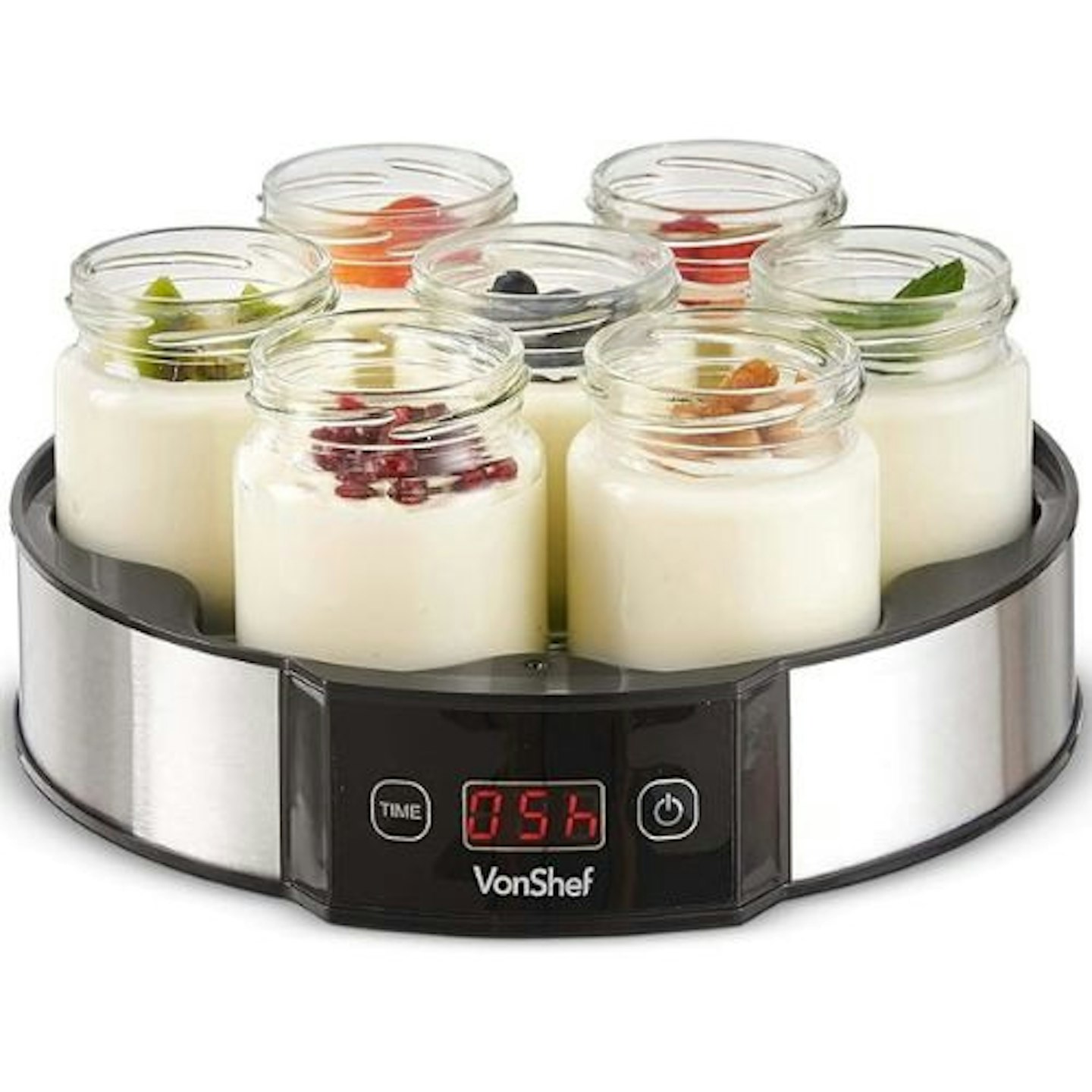 VonShef
VonShefThe VonShef Digital Yoghurt Maker is the best option for making individual servings of yoghurt because it comes with seven single-serve glass jars. Each jar holds 180ml, making them perfect for breakfast, snacks or taking on the go. Unlike large-batch yoghurt makers, this design allows for easy portion control, ensuring each serving is fresh and ready to enjoy without needing to scoop from a big container.
A key benefit of individual portions is convenience. The jars come with screw caps, so they can be sealed and stored in the fridge, keeping the yoghurt fresh for longer. This also makes them ideal for meal prepping, allowing you to make a week’s worth of yoghurt in advance. If you’re looking to cut down on plastic, these reusable glass jars are a great alternative to single-use yoghurt pots, helping to reduce waste while still enjoying your favourite snack.
The machine is easy to use, featuring an LCD display, timer and temperature monitor for precise control. It also uses a PTC heating component, making it more energy-efficient than other yoghurt makers. As one review puts it: "This little uncomplicated machine does a first class job, without any fuss."
By making yoghurt at home, you save money and avoid the hidden sugars and additives found in many shop-bought options. Plus, with seven jars, you can create different flavours in the same batch, giving you variety without extra effort. Whether enjoyed on its own, in a breakfast bowl, smoothie or savoury dish, this yoghurt maker is a great choice for anyone who loves fresh, homemade yoghurt in perfectly sized portions.
Pros
- Quick, convenient, and easy to use
- Comes with seven single-serve jars, ideal for breakfast or on the go
- LCD display, timer and temperature monitor for precise control
- Energy-efficient heating component
- Jars have screw caps for easy fridge storage
Cons
- Limited capacity compared to larger yoghurt makers
| Quantity of yoghurt per batch: | Each jar is 180ml (1260ml) |
| Dimensions: | 25.5 x 25.1 x 12cm |
Best non-electric yogurt maker
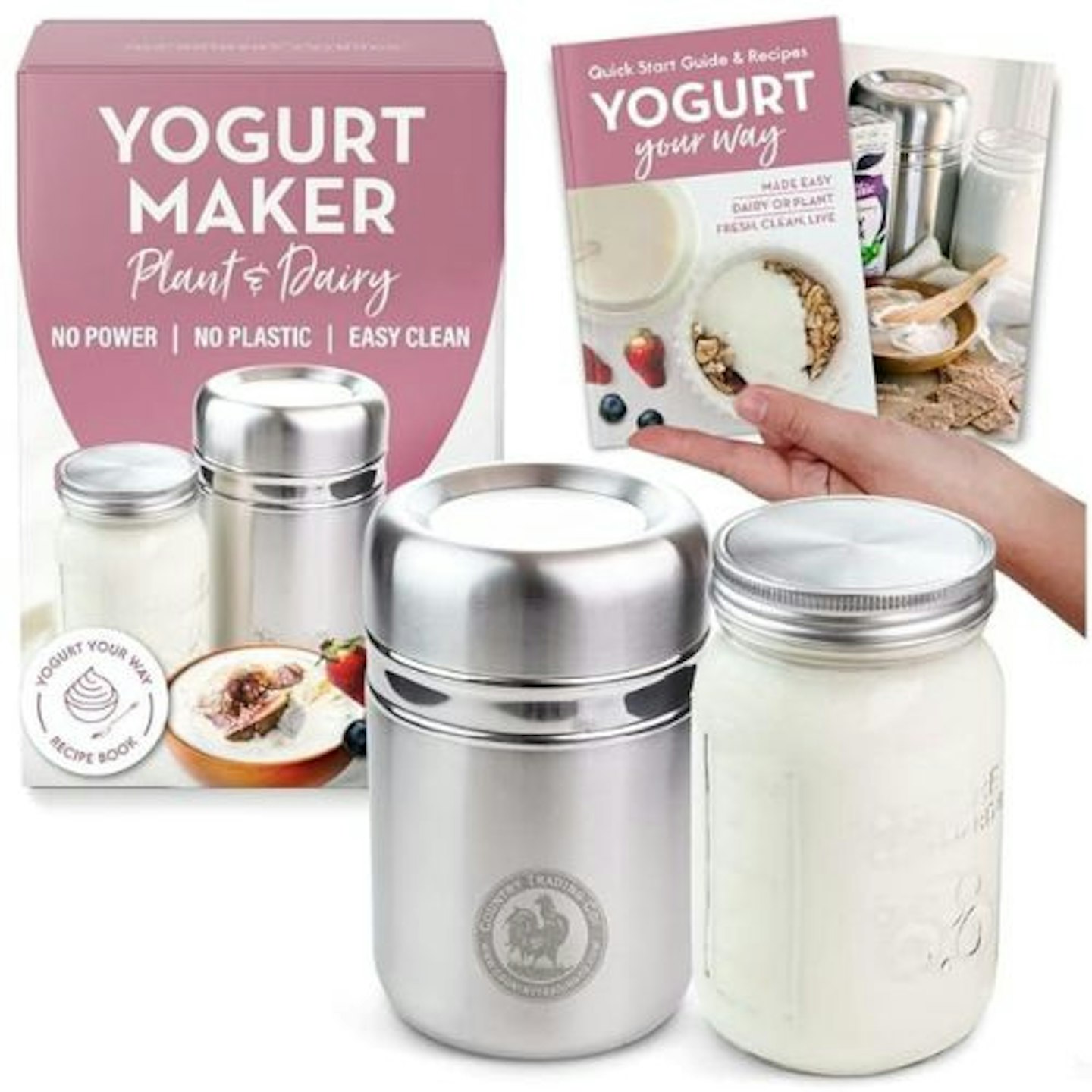 Country Trading Co. Store
Country Trading Co. StoreThis no-fuss yoghurt maker requires no power, timers, or complicated settings—just an old-fashioned jar. It’s dishwasher-safe for easy cleaning and can produce up to 1L of yoghurt, though it may be too large for small fridges. Since it’s not electric, there are no advanced features—what you see is what you get.
Instead of a basic instruction manual, you’ll receive a 42-page recipe book packed with expert tips to make over 12 types of yoghurt, including Greek, coconut and almond. With no added sugar or artificial ingredients, you can enjoy fresh, probiotic-rich yoghurt that supports gut health.
Looking for a yoghurt that fits your diet? You choose the milk and portion size to suit your needs, whether it's A2, keto, GAPS, SCD, or plant-based vegan yoghurt.
Plus, making your own yoghurt helps reduce plastic waste! The average household discards over 200 yoghurt tubs a year—switching to this reusable system is better for the planet and your wallet.
Customers love the high-quality design and creamy, thick-set yoghurt it produces. However, the large glass mason jars require careful handling as they can chip or break.
Pros
- No power or timers needed – simple to use
- Dishwasher safe for easy cleaning
- No-fuss, traditional yoghurt-making method
- Comes with a 42-page recipe book with various yoghurt options
- Helps reduce plastic waste and saves money
Cons
- Glass mason jars can chip or break if not handled carefully
- Lacks advanced features of electric yoghurt makers
| Quantity of yoghurt per batch: | Approximately 1L |
| Dimensions: | 12.5 x 12.5 x 20.5cm |
Best frozen yoghurt machine
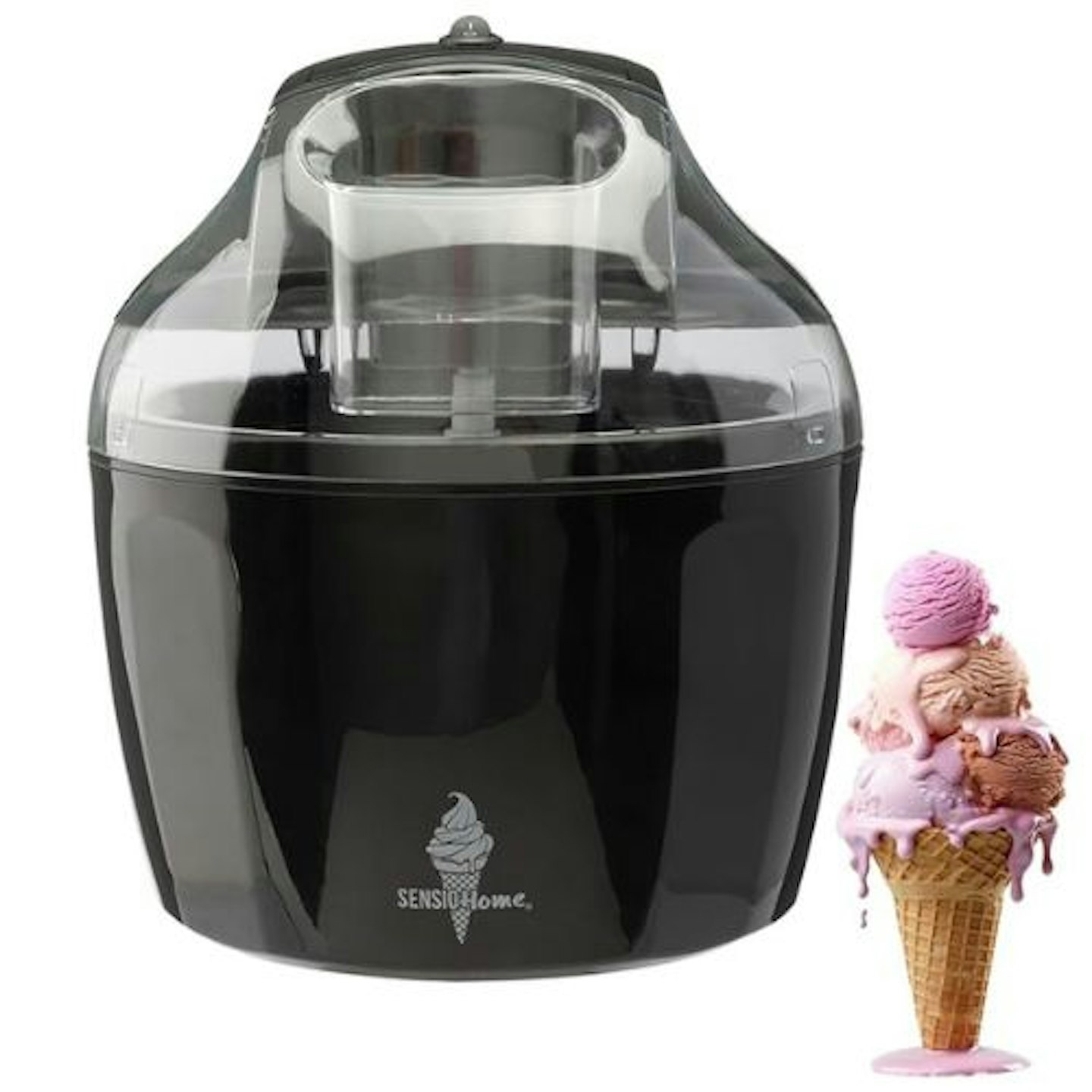 Sensio
SensioThis appliance isn't specifically for yoghurt making, but if you're looking for a healthier alternative to ice cream, it allows you to make frozen yoghurt, sorbet and gelato at home in just 20 minutes. With a 1.4L capacity and four removable components, you have full control over portion sizes and ingredients.
To use, simply freeze the bowl for 12 hours beforehand, mix your ingredients, and pour them in. The machine takes care of the rest, and the lid’s refill opening lets you add toppings as it churns. It’s an easy and cost-effective way to enjoy homemade frozen treats without additives.
Designed for convenience, the ice cream maker is simple to assemble and clean. As a trusted British brand since 1946, Sensio Home ensures quality and safety.
Customers love its performance, with one reviewer saying, "It makes delicious frozen yoghurt and ice cream." However, some note that it can be a bit noisy while in use.
Pros
- Makes frozen yoghurt, ice cream and sorbet quickly (in 20 minutes)
- 1.4L capacity with four components for portion control
- Easy to use, with a refill opening for adding toppings
- Simple to assemble and clean with four removable components
- Cost-effective alternative to store-bought frozen treats
Cons
- Can be a bit noisy while in operation
- Bowl requires 12 hours of freezing before use
| Quantity of yoghurt per batch: | Approximately 500ml |
| Dimensions: | 20 x 20 x 14cm |
Best yoghurt maker for portion sizing
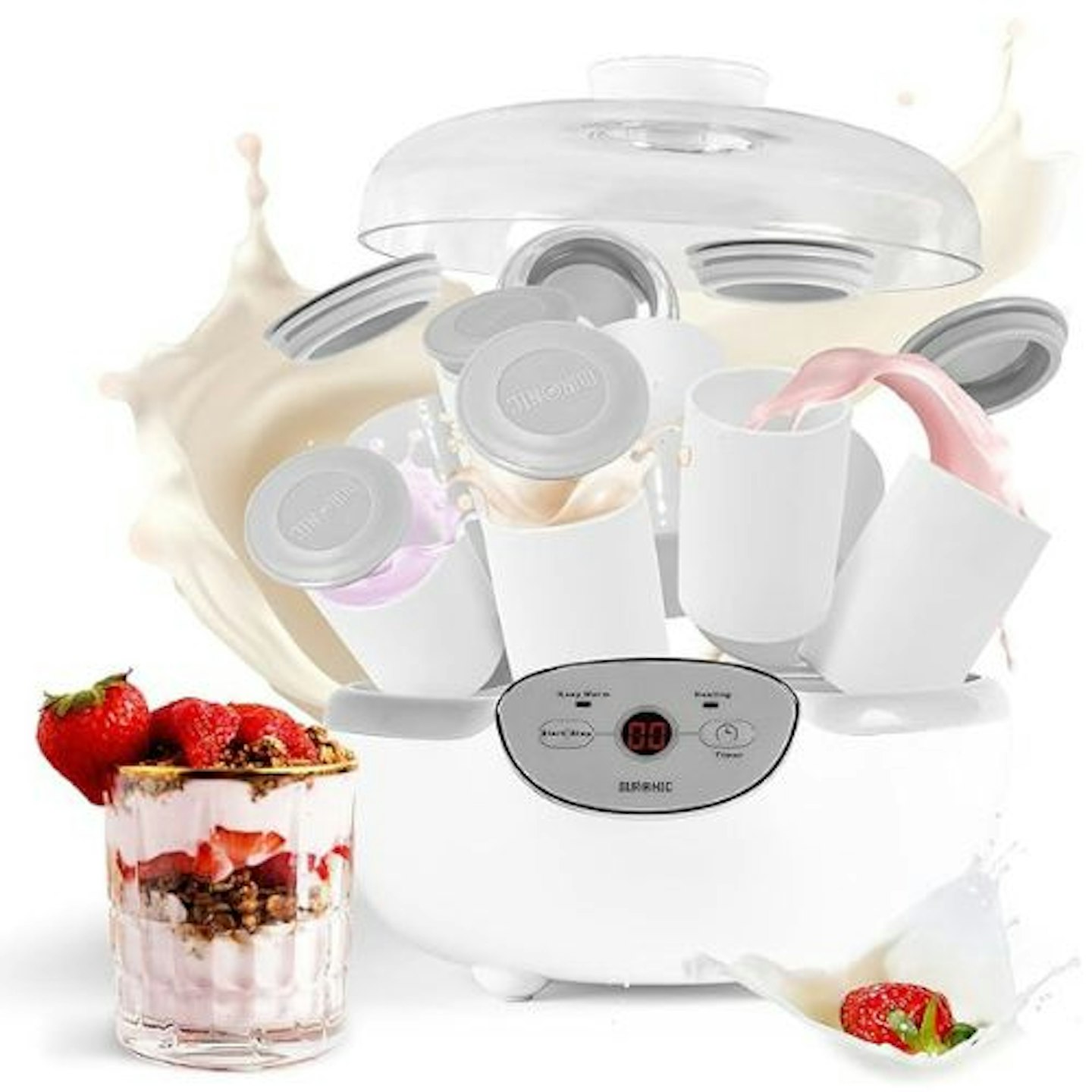 Duronic
DuronicCustomise the sweetness and flavour of each pot with the Duronic Yoghurt Maker YM2. It is easy to use and maintains a steady 35°C for fermentation, though the temperature isn't adjustable. If you're following a particular gut-healthy diet, you'll be pleased with the timer function that allows you to ferment yoghurt for up to 24 hours.
With individual pots, you can experiment with flavours by adding honey, fruit, chocolate or nuts for variety. Spare pots can be purchased separately. If you ever need a larger batch, this machine is also compatible with a 1.5L pot from the YM1 model.
If you’re health-conscious and want a simple way to make fresh, natural yoghurt at home, the Duronic YM2 digital yoghurt maker is a great choice. Just mix milk with a little fresh yoghurt starter, add any extra ingredients you like, and pour the mixture into the eight ceramic pots. Set the timer for your preferred texture, and let the machine do the rest.
Designed for ease of use, it has a simple digital control panel. Cleaning is quick—just wash the pots and wipe the base. Compact and lightweight, it’s easy to store and move around the kitchen.
This low-energy 20W machine gives you full control over your ingredients, helping you enjoy additive-free, probiotic-rich yoghurt tailored to your diet and taste.
Whether for a wholesome breakfast or a versatile ingredient in sweet and savoury dishes, the YM2 is a simple, family-friendly way to enjoy natural yoghurt at home. With a majority of five-star reviews on Amazon, customers agree that this is a great appliance for making portion-controlled homemade yoghurt.
Pros
- Easy to use
- Maintains a steady 38°C for fermentation
- Adjustable timer (8–12 hours)
- Makes individual pots for flavour variety
- Customisable with honey, fruit, chocolate, or nuts
Cons
- Its operating temperature is too high to grow Lactobacillus reuteri
| Quantity of yoghurt per batch: | 8 x 125ml pots |
| Dimensions: | 26 x 24 x 17cm |
Best yoghurt maker for flavour variety
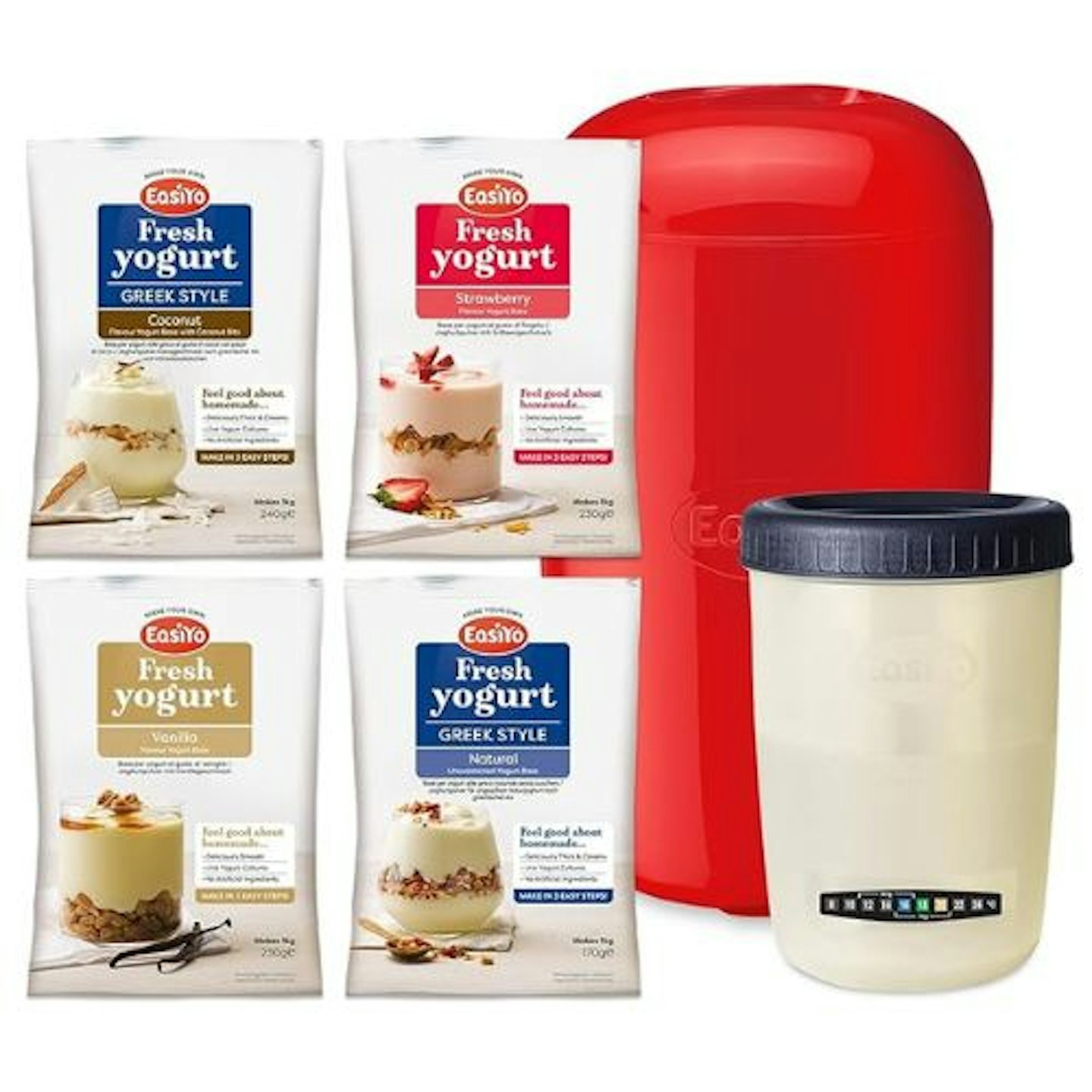 EasiYo
EasiYoWith EasiYo, making delicious flavoured homemade yoghurt is convenient. The EasiYo process makes it easy to prepare tasty flavoured yoghurt with powder mixes. It works like a Thermos flask to incubate the yoghurt without using electricity. Just add water to the jar, mix in the EasiYo powder, fill the maker with boiling water, and place the jar inside. Let it sit for 8–12 hours, then chill in the fridge. Customers love the creamy, delicious flavours, including: Natural, Strawberry, Vanilla and Greek Style with Coconut Bits. No artificial ingredients, packed with live cultures, calcium-rich, gluten-free, and vegetarian-friendly!
The flavoured sachets are widely available to buy on Amazon, and it's especially good value if you buy in bulk. There are some very moreish Dessert flavours, such as Chocolate Swirl and Greek yoghurt style too.
EasiYo is a hugely popular pick. It has five-star ratings from 77% of customers. As one satisfied customer puts it: "The taste is to die for." Plus, a closer look at the ingredients shows that EasiYo contains live yoghurt cultures, including S.thermophilus, L.bulgaricus, L.rhamnosus, L.helveticus. However, if you are allergic to soy or are watching your sugar intake, double-check the ingredients and nutritional information before buying lots of sachets to ensure it is suitable for your dietary requirements.
Pros
- No electricity needed
- Easy to use with powder mixes
- Incubates yoghurt like a Thermos flask
- Makes creamy, delicious flavours
- Requires 8–12 hours for fermentation
- Simple process with minimal steps
Cons
- It can go wrong if the water is at the wrong temperature or if too much water is added
| Quantity of yoghurt per batch: | 1kg |
| Dimensions: | 35.5 x 19.8 x 16.7cm |
What to consider when buying a yoghurt maker?
Temperature settings: If you are looking to make different kinds of soft cheese or yoghurts with kefir, you will need a lower temperature. Therefore, you will need a machine that has temperature controls. However, if it's just straightforward, plain yoghurt, you are looking to make then perhaps a manual yoghurt or no-frills yoghurt maker would suit you best such as the Lakeland Multi Yoghurt Maker, the VonShef Yoghurt Maker Machine or the Country Trading Co. Store Stainless Steel Yoghurt Maker.
Capacity: Yoghurt makers are designed in two ways, one is a machine with smaller individual pots for smaller servings, and the other is a big pot to make a large quantity at a time. Consider what you will need the yoghurt for - bulk batches or individual pots to narrow down your search.
Preparation times: Yoghurt usually takes around 10 hours for the fermentation process to finish. Automatic pre-sets are a helpful addition if you have never used a yoghurt maker before. Additionally, a machine that has an automatic shutdown function will allow your yoghurt maker to do the work without you needing to be around to switch it off.
Maintenance: The best machines are the ones that need minimal maintenance and cleaning. To ensure the longevity of your device, clean the blade components thoroughly after every use. It is best to hand wash the parts, but you can also consider purchasing a yoghurt maker with dishwasher-safe components and jars.
Design: If you haven't got a lot of space in your kitchen, it is best to pick a more compact yoghurt maker that will take up less counter and cupboard space.
Yoghurt starter cultures and mason jars
This Yoghurt Starter Culture pack comes with 10 freeze-dried sachets.

This four-pack of 14 oz glass mason jars (1 pint) are perfect for preserving, canning or storing yoghurt.
Ask the expert about the benefits of gut-friendly yoghurt
We spoke to Angelica Karydi, NPD & Technical Director at The Coconut Collab, to understand what makes a good, gut-friendly yoghurt.
How does homemade yoghurt support gut health?
To make a fermented product like yoghurt, you need live cultures (also known as bacteria!), which plays a key role in the process, eating up the sugar in the base of the yoghurt (such as the milk) and creating a drop in the pH (increasing the acidity level).
Some of this bacteria is what we call ‘gut-friendly’ – which typically means that they can survive the stomach digestion and reach the gut, helping with our gut microflora balance and promoting gut health as part of a balanced diet.
To achieve this outcome, it’s important to opt for a live culture that consists of strains that not only ferment, but which are also known probiotic or gut-friendly bacteria, such as the Lactobacillus and Bifidobacterium species. At The Coconut Collab, we use these strains – together with others – in all of our yoghurts, in order to maximise gut health benefit.
How the fermentation is achieved also influences the number of remaining bacteria within the yoghurt – depending on the base, the temperature, and the time of fermentation, you can have billions of live cultures within the product.
What are the best types of milk to use for making yoghurt?
As the leading dairy-free coconut yoghurt brand, we opt to use coconut milk for its excellent taste and texture, which makes our yoghurts super creamy, and which delivers our signature ‘cloud-like’ style that our customers know and love.
Coconut milk is naturally low in sugar – which also means that our yoghurts are typically lower in sugar than other options – and so, if you opt to use this to produce yoghurt at home, you might find it easier to add rice milk to provide enough sugar for the bacteria to break down during fermentation.
If preferred, you can use dairy milk within the process, or other plant-based milks such as oat and almond would also work well.
How does temperature control affect yoghurt quality?
Temperature during fermentation is super important, but storage temperature can be equally important.
During fermentation, the bacteria tend to prefer temperatures of up to 40°C – anything above that can kill some of the strains and allow for the overactivity of others. For best results, we recommend that you check what the culture you are using prefers in terms of temperature - different bacteria will give off different tastes and even textures in the yoghurt.
Storage temperature is important for maintaining the pH of the product to the desired level. If there are enough natural sugars in the recipe and the yoghurt is stored out of the fridge, it will continue to ferment and perhaps go too sour. It is important that when the desired pH is reached, the product is put in the fridge to protect it from fermenting further – or even to prevent the growth of yeasts and moulds.
What are some common mistakes people make when making yoghurt at home?
Fermentation is a form of art and there are many pitfalls to watch out for. These include:
• Getting the temperature wrong – as the fermentation process is highly temperature-dependent, this can cause all sorts of issues, from killing the bacteria entirely – resulting in no yoghurt; through to over-fermentation, in which you end up with an overly sour or acidic taste.
• Getting the duration of the fermentation wrong – this is a critical factor in making yoghurt, so getting it wrong can result in issues such as an underdeveloped texture, curdling, or a weak – or overly sour – taste.
• Weak starter culture dosing – using a lower-than-typical amount of microbial starter culture to begin the fermentation process can negatively influence the result.
• Wrong storage conditions – this can cause negative effects ranging from changes in texture and flavour, through to the loss of beneficial bacteria. Storing it in the fridge at 4°C or below maintains its freshness and prevents spoilage, whilst using an airtight container helps protect the yoghurt from exposure to air and contaminants.
For those who want to first seek inspiration, I highly recommend trying The Coconut Collab’s range of delicious, natural yoghurts which come in a range of flavours and with a range a benefits – such as our new Strawberry Protein yoghurt, which includes an added pop of plant-based protein.
How to use a yoghurt maker
After you have chosen a yoghurt maker, you will need a few other essentials to get started such as starter yoghurt packets, fresh milk or non-dairy milk and mason jars. You will also require a saucepan to boil the milk, a ladle, a mixing bowl and a thermometer.
This simple video tutorial from Lakeland shows you how to make yoghurt at home using their Lakeland Multi Yoghurt and Soft Cheese Maker.
A few tips for making homemade yoghurt
Sterilise your jars: You don’t want the yoghurt cultures contending with any bacteria in your pots and jars as you will not get the probiotic benefits.
Non-dairy starter: If you are vegan or lactose intolerant, you can use specialised non-dairy yoghurt starter powder.
No metal spoons: Don't use any metal spoons to mix the milk or yoghurt starter, as it will deactivate the probiotics.
In a pinch, you can actually use two tablespoons of store-bought unflavoured yoghurt as a yoghurt starter or even a probiotic capsule that provides up to 30 billion CFU’s.
Best yoghurt maker FAQs
What are the benefits of an electric yoghurt maker?
An electric yoghurt maker offers convenience and consistency by controlling the temperature precisely, ensuring great results every time. Compared to buying store-bought yoghurt, it also helps reduce plastic waste, and it's cheaper.
How do I use an electric yoghurt maker?
To use a yoghurt maker, heat milk to 90°C to kill bacteria, or use UHT milk to skip this step. Let it cool to room temperature, then add some store-bought live yoghurt as a starter. Pour the mixture into the yoghurt maker, set the timer, and let it ferment. Save a small amount of your homemade yoghurt to use as a starter for your next batch. You can even freeze the starter culture for later use.
How much does a yoghurt maker cost?
Yoghurt makers in the UK range from £20 to £100, depending on the brand, features, and size. Basic models start around £20, while advanced ones can go up to £100.
Is a yoghurt maker worth it?
Yes, if you enjoy homemade yoghurt often, a yoghurt maker is definitely worth it. It saves you money, allows you to control the ingredients, and provides better-tasting yoghurt than store-bought versions.
Can you make homemade yoghurt with skimmed milk?
Yes, you can. While the yoghurt may be thinner than using whole milk, you can still achieve a creamy texture by following the right method. Some recipes recommend adding dried skimmed milk powder for extra creaminess.
What is a yoghurt culture?
A yoghurt culture is a blend of live bacteria that ferment milk into yoghurt. The bacteria, typically Lactobacillus bulgaricus and Streptococcus thermophilus, convert the milk’s lactose into lactic acid, which thickens the milk and gives yoghurt its tangy flavour. Starter cultures for specific yoghurt types (like Bulgarian or Lebanese) are also available online.
Can I make yoghurt from soy milk?
You can use soy milk to make yoghurt in a yoghurt maker. Many models are versatile enough to handle non-dairy milk options.
Can I make Greek yoghurt with a yoghurt maker?
Yes, some yoghurt makers come with a straining accessory to remove excess whey, allowing you to make thick, creamy Greek yoghurt.
Can I make frozen yoghurt with a yoghurt maker?
You specifically need an ice cream maker for this, whereby you can turn your homemade yoghurt into healthy, budget-friendly frozen yoghurt.
This article includes expert commentary from Angelica Karydi, NPD & Technical Director, at The Coconut Collab. The Coconut Collab is one of the fastest growing yoghurt brands, renowned for its thick, fluffy, and natural yogurts that are crafted with coconut, and are infused with coconut water for natural sweetness, minimal processing, and unique taste and texture.
Ellen Kinsey was a Senior Health and Wellness Product Writer and has been a part of Bauer Media since 2020. She has left to study Ayurveda in India to expand her knowledge and skills in the health and wellness field, where she plans to continue making journalistic contributions.





